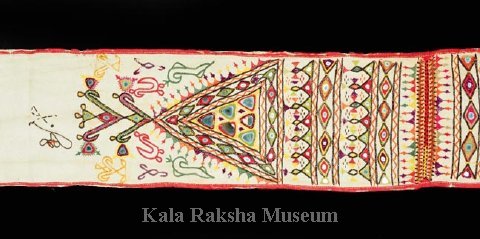|
Description
|
| MATERIALS: Cotton, drill and madrasi cloth, cotton and silk threads and mirrors. CONSTRUCTION: Made in two parts pieced together, embroidered portion is lined, pipijng, hand stitched, joined by embroidered khilan, embroidered; chain, interlaced, cretan, herringbone, detached chain, double buttonhole, fishbone, buttonhole filling stitches. MOTIFS: Popti, makodiyun, tak bawaliyun, baporiya, hindhoni, butti deri, mor, sudo, vichhi, jharmar and limbudi tak. COLOURS :Multicoloured on white and red. STYLE REMARKS: Oldest existent Rabari style practised until 1940's and 50's. Colours and motifs are conventionl. Older style used figural motifs. The bokani is usually made in two symmetrical pieces, which are stitched together in the cectre. The use of two colours is traditional. In the oldest pieces, white with red borders was preferred. The overall pattern in the centre is specifically for bokanis, as is an end pattern of a triangle and tree. CULTURAL SIGNIFICANCE: The bokani is a desert garment, worn over a man's chin, turban, and ears (hence the name, in Sindhi ''bo (two) kan (ears).'' It was traditionally worn by a young groom to protect his tender face and valuable earrings from desert winds. CULTURAL REMARKS: Today, bokanis are worn as ascots or belts, often embroidered on Imported Middle Eastern cloths. Bokani, groom's scarf. |
Bokani
-Rabari Arts
-Copyright Statement

COPYRIGHT INFORMATION ~ When using this image, the credit information should be in the following format: Image courtesy of the Kala Raksha Museum.

COPYRIGHT INFORMATION ~ When using this image, the credit information should be in the following format: Image courtesy of the Kala Raksha Museum.